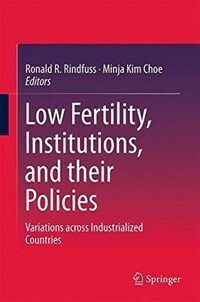
Low fertility, institutions, and their policies: variations across industrialized countries
- 발행사항
- Switzerland: Springer, 2016
- 형태사항
- 303p. : charts; 25cm
- ISBN
- 9783319329956
- 청구기호
- 322.92 M665l
- 서지주기
- Includes bibliographical references
소장정보
| 위치 | 등록번호 | 청구기호 / 출력 | 상태 | 반납예정일 |
|---|---|---|---|---|
이용 가능 (1) | ||||
| 1자료실 | 00016114 | 대출가능 | - | |
- 등록번호
- 00016114
- 상태/반납예정일
- 대출가능
- -
- 위치/청구기호(출력)
- 1자료실
책 소개
This volume examines ten economically advanced countries in Europe and Asia that have experienced different levels of fertility decline. It offers readers a cross-country perspective on the causes and consequences of low birth rates and the different policy responses to this worrying trend.
The countries examined are not only diverse geographically, historically, and culturally, but also have different policies and institutions in place. They include six very-low-fertility countries (Austria, Czech Republic, Hungary, Italy, Spain, and Taiwan) and four that have close to replacement-level fertility (United Kingdom, Norway, Canada, and France).?
Although fertility has gone down in all these countries over the past 50 years, the chapters examine the institutional, policy, and cultural factors that have led some countries to have much lower fertility rates than others. In addition, the final chapter provides a cross-country comparison of individual perceptions about obs
tacles to fertility, based on survey data, and government support for families. This broad overview, along with a general introduction, helps put the specific country papers in context.?
As birth rates continue to decline, there is increasing concern about the fate of social welfare systems, including healthcare and programs for the elderly. This book will help readers to better understand the root causes of such problems with its insightful discussion on how a country’s institutions, policies, and culture shape fertility trends and levels.
New feature
This volume examines ten economically advanced countries in Europe and Asia that have experienced different levels of fertility decline. It offers readers a cross-country perspective on the causes and consequences of low birth rates and the different policy responses to this worrying trend.
The countries examined are not only diverse geographically, historically, and culturally, but also have different policies and institutions in place. They include six very-low-fertility countries (Austria, Czech Republic, Hungary, Italy, Spain, and Taiwan) and four that have close to replacement-level fertility (United Kingdom, Norway, Canada, and France).?
Although fertility has gone down in all these countries over the past 50 years, the chapters examine the institutional, policy, and cultural factors that have led some countries to have much lower fertility rates than others. In addition, the final chapter provides a cross-country comparison of individual perceptions about obs
tacles to fertility, based on survey data, and government support for families. This broad overview, along with a general introduction, helps put the specific country papers in context.?
As birth rates continue to decline, there is increasing concern about the fate of social welfare systems, including healthcare and programs for the elderly. This book will help readers to better understand the root causes of such problems with its insightful discussion on how a country’s institutions, policies, and culture shape fertility trends and levels.
목차
Forward: Sangho Kim.- 1. Diverse paths to low and lower fertility: An overview : Ronald R Rindfuss and Minja Kim Choe.- 2. Not so low fertility in Norway-a result of affluence, liberal values, gender-equality ideals, and the welfare state: Øystein Kravdal.- 3. The influence of family policies on fertility in France: Lessons from the past and prospects for the future: Olivier Thevenon.- 4. Fertility and population change in the United Kingdom: Wendy Sigle.- 5. Canadian fertility trends and policies: A story of regional variation: Sarah R. Brauner-Otto.- 6. The European middle way? Low fertility, family change, and gradual policy adjustments in Austria and the Czech Republic: Tomas Sobotka.- 7. Fertility decline and the persistence of low fertility in a changing policy environment-a Hungarian case study: Zsolt Speder.- 8. The policy context of fertility in Spain: Toward a gender-egalitarian model?: Pau Baizan.- 9. Aging Italy: Low fertility and societal rigidities: Maria Letizia Tanturri.- 10. Transition from anti-natalist to pro-natalist policies in Taiwan: Meilin Lee and Yu-Hsuan Lin.- 11. Governmental support for families and obstacles to fertility in East Asia and other industrialized regions : Anne H. Gauthier.



